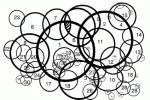Barry wellman argues that “Many analysts view social networks much as aliens might view the earth’s people: hovering above and observing the relationships linking all members of the population”. This is the Copernican view of an entire social system. And Barry Wellman continues “..whole network studies are not always feasible or analytically appropriate. Those who use them must define the boundaries of a population, compile a list of all members of this population , and collect a list of all the relationships (of the sort the analyst is interested in) among the members of the population.” After presenting this argument, Wellman declares his position: “Therefore many community network analysts … have concentrated on studying smaller personal (or ego-centered) networks defined from the stand point of focal persons: a sample of individuals at the centers of their own networks. Rather than showing the universe as it is viewed by an outside observer, personal network studies provide Ptolemaic views of networks as they may be viewed by the individuals at their centers: the world we each see revolving around us.”
Although I understand and acknowledge the importance of a Ptolemaic view on a social network, which is more close to a psychologist, I don’t understand why Wellman, a sociologist, prefer this view over Copernican view, which I think is more “sociological” and as important as the “psychological” view. I think both ways of looking at a social network is very valuable and can answer to different, complementary research questions. I think in his effort to reject the term of community and recognize only social networks, Wellman adopts the Ptolemaic View. Copernican view results to the term of community, not necessarily locally determined, but to a clearly bounded group of people according to “a list of all the relationships (of the sort the analyst is interested in)…”, that is a kind of shared identity or common aim/challenge/interest. Wellman argues that a group is just a densely knit and tightly bounded type of social networks. He prefers to recognize these structures as special sub-clusters in a person’s personal network.



